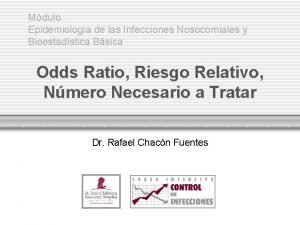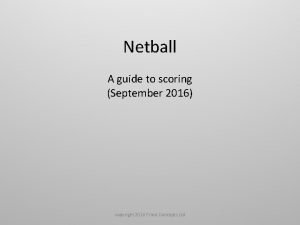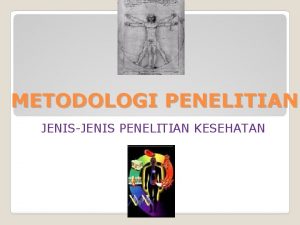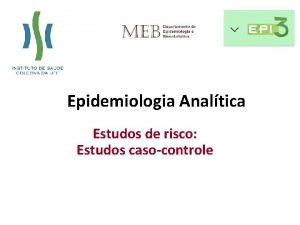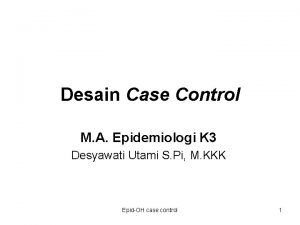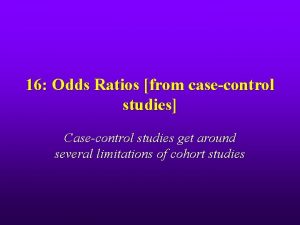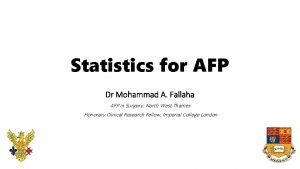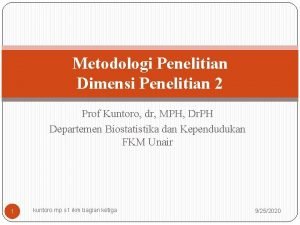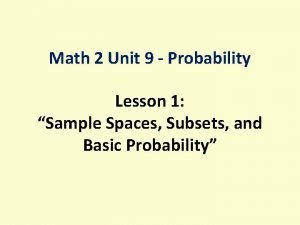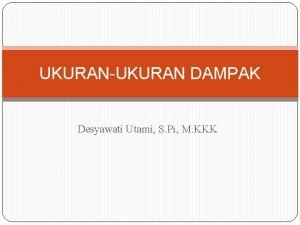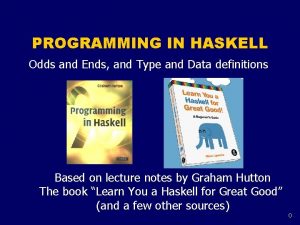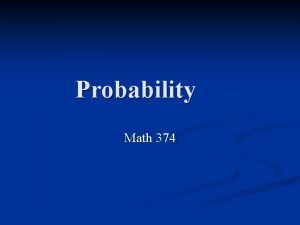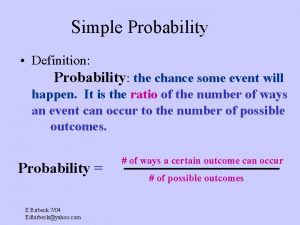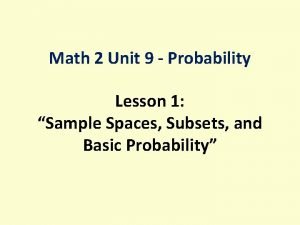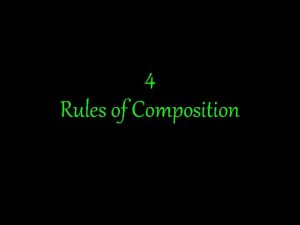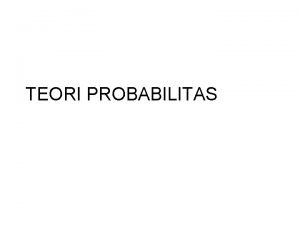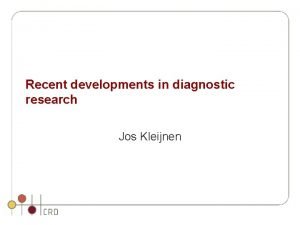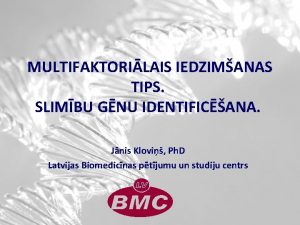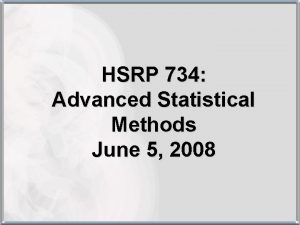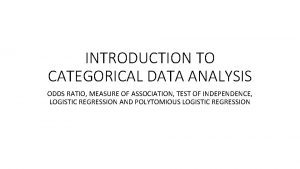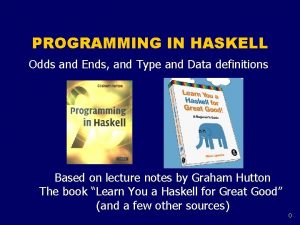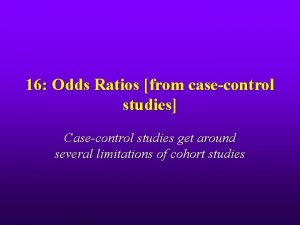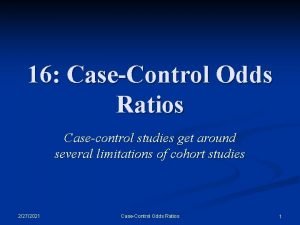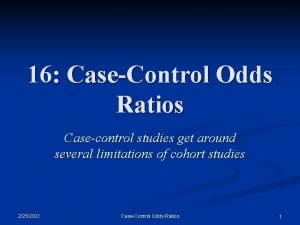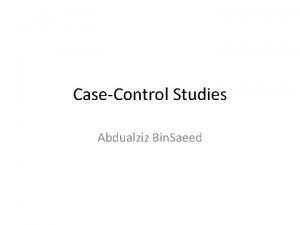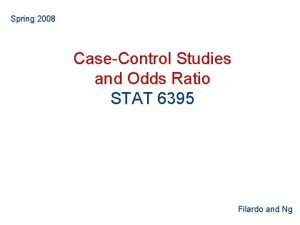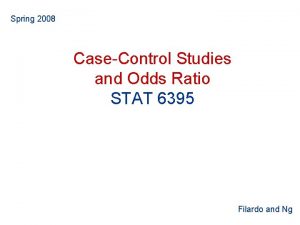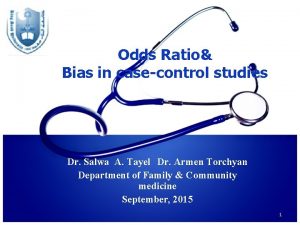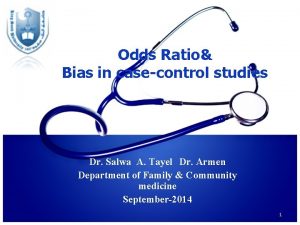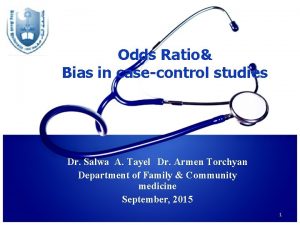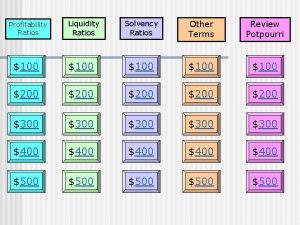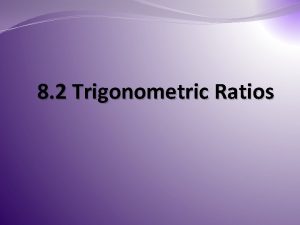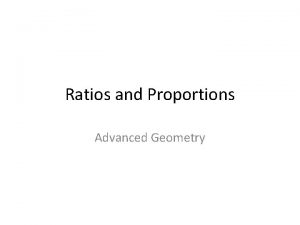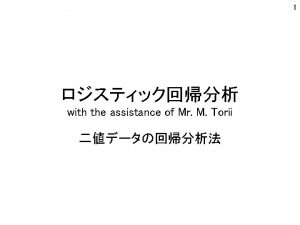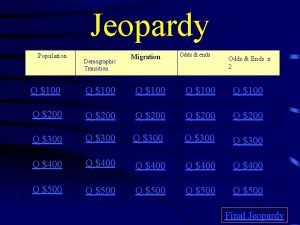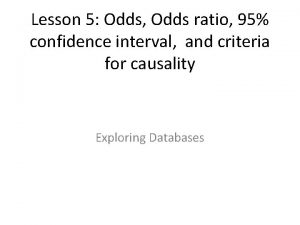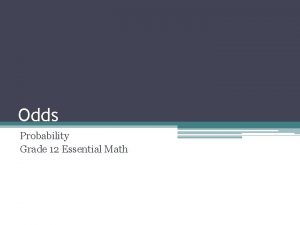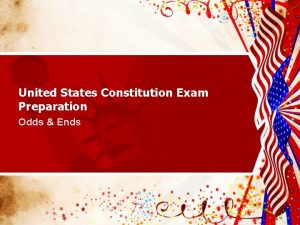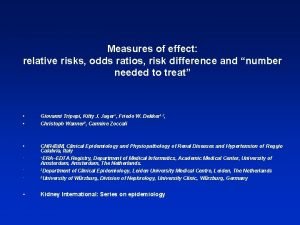16 Odds Ratios from casecontrol studies Casecontrol studies
![16: Odds Ratios [from case-control studies] Case-control studies get around several limitations of cohort 16: Odds Ratios [from case-control studies] Case-control studies get around several limitations of cohort](https://slidetodoc.com/presentation_image/2d50ecde091fef0b6a2ebaccb076200a/image-1.jpg)



























- Slides: 28
![16 Odds Ratios from casecontrol studies Casecontrol studies get around several limitations of cohort 16: Odds Ratios [from case-control studies] Case-control studies get around several limitations of cohort](https://slidetodoc.com/presentation_image/2d50ecde091fef0b6a2ebaccb076200a/image-1.jpg)
16: Odds Ratios [from case-control studies] Case-control studies get around several limitations of cohort studies

Cohort Studies (Prior Chapter) • Use incidences to assess risk • • • Exposed cohort incidence 1 Non-exposed cohort incidence 0 Compare incidences via risk ratio ( )

Hindrances in Cohort Studies • • Long induction between exposure & disease may cause delays Study of rare diseases require large sample sizes to accrue sufficient numbers When studying many people information by necessity can be limited in scope & accuracy Case-control studies were developed to help overcome some of these limitations

Levin et al. (1950) Historically important study (not in Reader) • Selection criteria • 236 lung cancer cases -- 156 (66%) smoked • 481 non-cancerous conditions (“controls”) -212 (44%) smoked • Although incidences of lung cancer cannot be determined from data, we see an association between smoking and lung cancer

How do we quantify risk from case -control data? • • Two article shed light on this question Cornfield, 1951 Cornfield, J. (1951). A method of estimating comparative rates from clinical data. Application to cancer of the lung, breast, and cervix. Journal of the National Cancer Institute, 11, 1269 -1275. • Miettinen, 1976 Miettinen, O. (1976). Estimability and estimation in case-referent studies. American Journal of Epidemiology, 103, 226 -235.

Cornfield, 1951 • • Justified use of odds ratio as estimate of relative risk Recognized potential bias in selection of cases and controls

Miettinen, 1976 • Conceptualized case-control study as nested in a population • all population cases studied • sample of population non-cases studied

Miettinen (1976) Density Sampling • Imagine 5 people followed over time At time t 1 (shaded), D occurs in person 1 • You select at random a non-cases at this time • Note: person #2 becomes a case later on but can still serve as a control at t 1

How incidence density sampling works The ratio of exposed to non-exposed time in the controls estimates the ratio of exposed to nonexposed controls in the population (see EKS for details)

Data Analysis • • • Ascertain exposure status in cases and controls Cross-tabulate counts to form 2 -by-2 table Notation same as prior chapter Exposed + Exposed Total Disease + Disease - Total A 1 A 0 M 1 B 0 M 0 N 1 N 0 N

Calculate Odds Ratio ( ^) Exposed + Exposed Total Disease + Disease - Total A 1 A 0 M 1 B 0 M 0 N 1 N 0 N Cross-product ratio

Illustrative Example (Breslow & Day, 1980) • Dataset = bd 1. sav • Exposure variable (alc 2) = Alcohol use dichotomized • Disease variable (case) = Esophageal cancer Alcohol 80 g/day < 80 g/day Total Case 96 104 200 Control 109 666 775 Total 205 770 975

Interpretation of Odds Ratio • Odds ratios are relative risk estimates • Risk multiplier • e. g. , odds ratio of 5. 64 suggests 5. 64× risk with exposure • Percent relative risk difference = (odds ratio – 1) × 100% • e. g. , odds ratio of 5. 64 • Percent relative risk difference = (5. 64 – 1) × 100% = 464%

95% Confidence Interval • Calculations • • • Convert ψ^ to ln scale selnψ^ = sqrt(A 1 -1 + A 0 -1 + B 1 -1 + B 0 -1) 95% CI for lnψ = (lnψ^) ± (1. 96)(se) Exponentiate limits Illustrative example • ln(ψ^) = ln(5. 640) = 1. 730 • selnψ^ = sqrt(96 -1 + 104 -1 + 109 -1 + 666 -1) = 0. 1752 • 95% CI for lnψ = 1. 730 ± (1. 96)(0. 1752) = (1. 387, 2. 073) • 95% CI for ψ = e(1. 387, 2. 073) = (4. 00, 7. 95)

SPSS Output Odds ratio point estimate and confidence limits Ignore “For cohort” lines when data are case-control

Interpretation of the 95% CI • • • Locates odds ratio parameter (ψ) with 95% confidence Illustrative example: 95% confident odds ratio parameter is no less than 4. 00 and no more than 7. 95 Confidence interval width provides information about precision

Testing H 0: ψ = 1 with the Confidence Interval • • 95% CI corresponds to a =. 05 If 95% CI for odds ratio excludes 1 odds ratio is significant • e. g. , (95% CI: 4. 00, 7. 95) is a significant positive association • e. g. , (95% CI: 0. 25, 0. 65) is a significant negative association • If 95% CI includes 1 odds ratio NOT significant • e. g. , (95% CI: 0. 80, 1. 15) is not significant (i. e. , cannot rule out odds ratio parameter of 1 with 95% confidence

p value • • H 0: ψ = 1 (“no association”) Use chi-square test (Pearson’s or Yates’) or Fisher’s test, as covered in prior chapters Fisher’s exact test by computer

Chi-Square, Pearson OBSER VED D+ D- Total EXPEC TED D+ D- Total E+ 96 109 205 E+ 42. 051 162. 949 205 E- 104 666 770 E- 157. 949 612. 051 770 Total 200 775 975 c 2 Pearson's = (96 - 42. 051)2 / 42. 051 + (109 – 162. 949)2 / 162. 949 + (104 - 157. 949)2 / 157. 949 + (666 – 612. 051)2 / 612. 051 = 69. 213 + 17. 861 + 18. 427 + 4. 755 = 110. 256 c = sqrt(110. 256) = 10. 50 off chart (way into tail) p <. 0001

Chi-Square, Yates OBSER VED D+ D- Total EXPEC TED D+ D- Total E+ 96 109 205 E+ 42. 051 162. 949 205 E- 104 666 770 E- 157. 949 612. 051 770 Total 200 775 975 c 2 Pearson's = (|96 - 42. 051| - ½)2 / 42. 051 + (|109 – 162. 949| - ½)2 / 162. 949 + (|104 - 157. 949| - ½)2 / 157. 949 + (|666 – 612. 051| - ½)2 / 612. 051 = 67. 935 + 17. 532 + 18. 087 + 4. 668 = 108. 221 c = sqrt(108. 22) = 10. 40 p <. 0001

SPSS Output Pearson = uncorrected Yates = continuity corrected Fisher’s unnecessary here Linear-by-linear not covered

Interpreting the p value • • "If the null hypothesis were correct, the probability of observing the data is p“ e. g. , p =. 000 suggests association is unlikely due to chance (we can be confident in rejecting H 0)

Validity! • Before you get too carried away with the odds ratio (or any other statistic), remember they assume validity • No info bias (exposure and disease accurately classified) • No selection bias (cases and controls are fair reflection of population analogues) • No confounding

Matched-Pairs • Matching can be employed to help control for confounding • e. g. , matching on age and sex • • Each pair represents an observation Classify each pair • Concordant pairs • • case is exposed & control is exposed case is non-exposed & control is non-exposed • Discordant pairs • • case is exposed & control is non-exposed case is non-exposed & control is exposed

Tabulation & Notation Tabular display is optional Case exposed Case non-exposed Control non-exposed t u v w Odds ratio for matched pair data:

Example (Matched Pairs) Case exposed Case non-exposed Control non-exposed 5 30 10 5

Confidence Interval for Matched Pairs

Mc. Nemar’s Test for Matched Pairs H 0: ψ = 1 (“no association”) df = 1 for Mc. Nemar’s OK to convert to chi-statistic chi-table
 Riesgo relativo
Riesgo relativo Netball odds and evens
Netball odds and evens Perencanaan penelitian kesehatan
Perencanaan penelitian kesehatan Odds and ends kingdom
Odds and ends kingdom Caso controle
Caso controle Relative risk dan odds ratio
Relative risk dan odds ratio Odds ratio interprétation
Odds ratio interprétation Odds of getting pregnant
Odds of getting pregnant Rr statistics
Rr statistics Contoh penelitian non reaktif
Contoh penelitian non reaktif Tft dice odds
Tft dice odds Rumus odds ratio
Rumus odds ratio Calcular odds ratio
Calcular odds ratio Odd haskell
Odd haskell Nna odds
Nna odds Simple definition of probability
Simple definition of probability Odds ratio interprétation
Odds ratio interprétation Sample space probability worksheet
Sample space probability worksheet Perbedaan relative risk dan odds ratio
Perbedaan relative risk dan odds ratio Rule of thirda
Rule of thirda Contoh soal pendekatan subjektif
Contoh soal pendekatan subjektif Diagnostic odds ratio
Diagnostic odds ratio Slimbu
Slimbu Odd ratio
Odd ratio Biserial correlation formula
Biserial correlation formula Tula lit raisa stain
Tula lit raisa stain Haskell odds
Haskell odds Paradigm shift from women studies to gender studies
Paradigm shift from women studies to gender studies Safe staffing ratios benefiting nurses and patients
Safe staffing ratios benefiting nurses and patients
